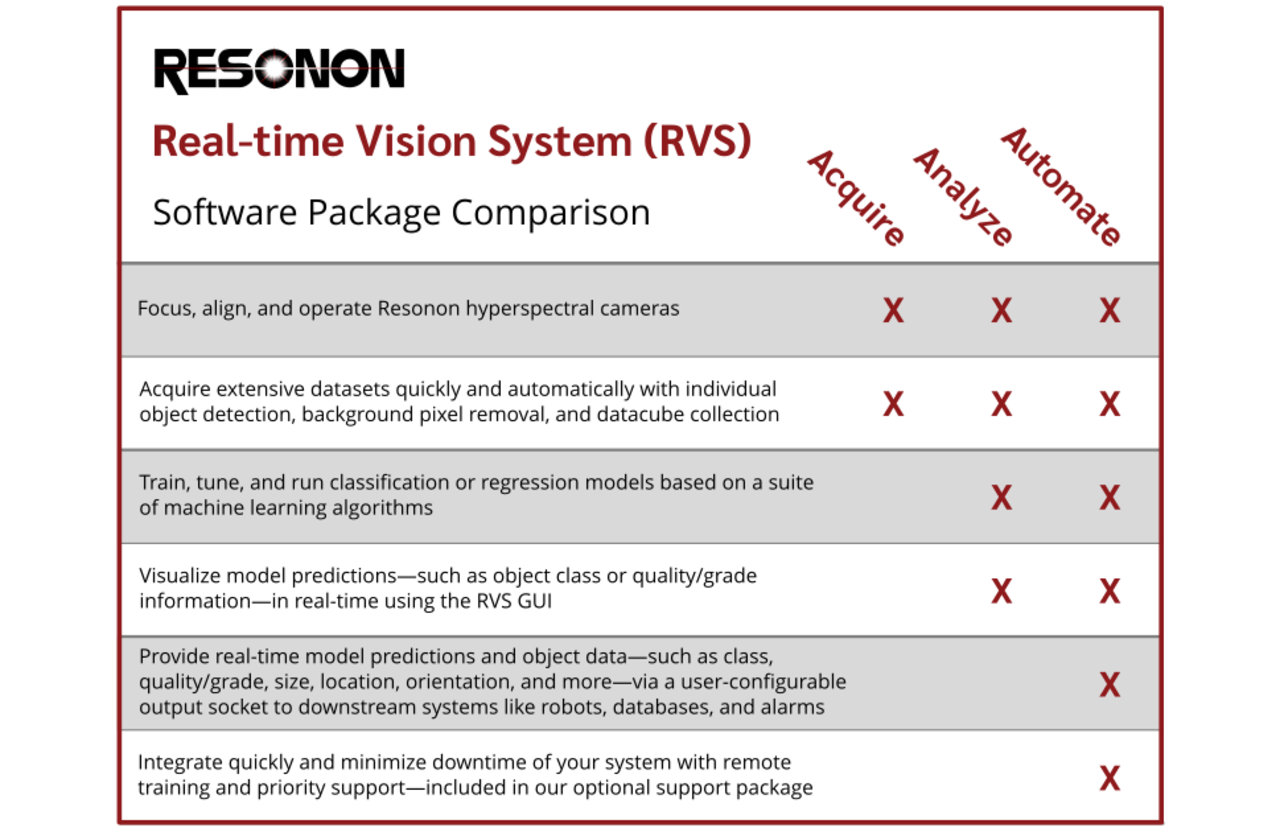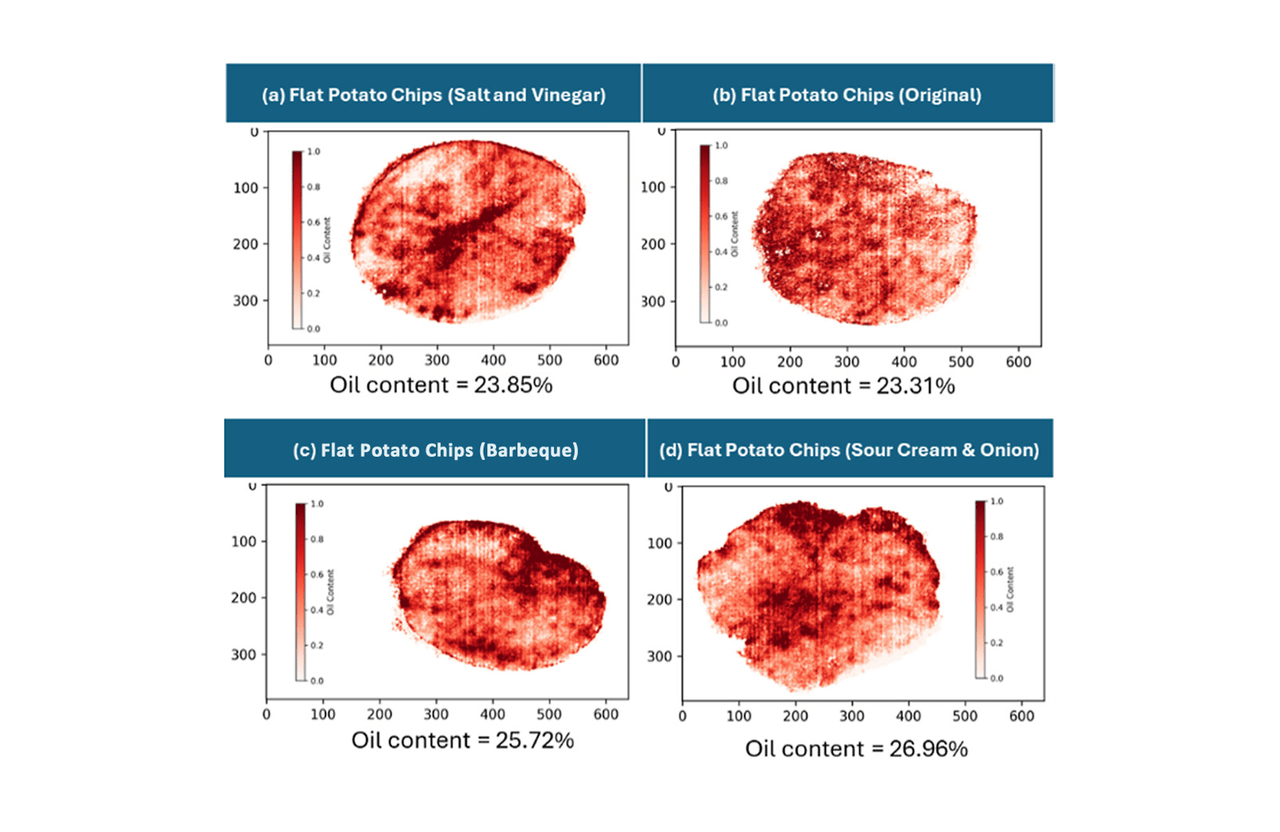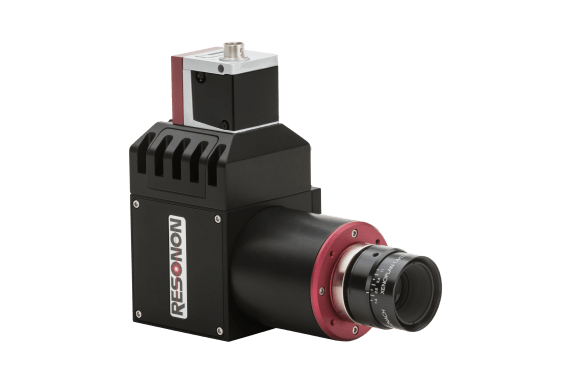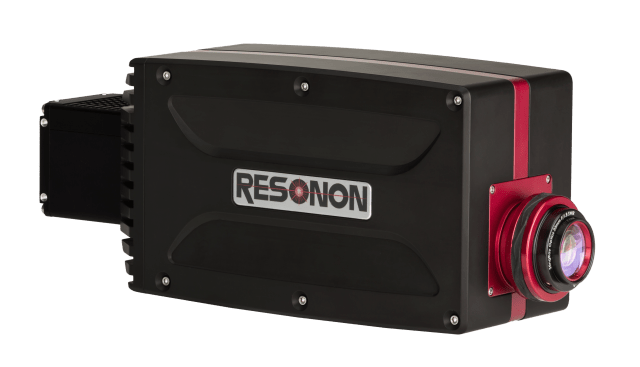

Hyperspectral Machine Vision
Automated Optical Sorting and Quality Control
RVS Software
Real-time Vision System
Resonon's RVS software is used in industrial installations at leading companies in food production, manufacturing, and recycling. There are three RVS versions:
RVS - Acquire, RVS - Analyze, and RVS - Automate (version details)
The videos demonstrate how quick and easy it is to use RVS in your optical sorting, grading, or quality control system, without any knowledge of hyperspectral imaging or machine learning.
For a benchtop-sized system capable of running RVS (for laboratories or industrial feasibility tests), see our SpectralSight™ System.
Machine Vision System Implementation Process
Our machine vision implementation process typically involves the following steps:
1. Feasibility Study (typically no cost)
- You send samples and we provide you with a feasibility report.
- We collaborate to define key parameters, including: conveyor dimensions, speed, object size, resolution, and desired outputs (e.g., sorting robot integration).
2. Pilot Study (if necessary)
- After a successful feasibility study, we provide estimates for a pilot study and the implemented system.
- Preferably, the pilot study occurs at your site to replicate the actual operating environment.
3. Full System Implementation
- After a successful pilot study, we can provide full system implementation: permanent fixtures, lighting, software development, and integration with other equipment (e.g., sorting robots)
- Flexible Integration Options: full integration, collaboration with you or your system integrator, or a recommendation for a suitable integrator.
Contact us to discuss getting started with your samples.
RVS Software Packages
- RVS - Acquire enables object detection and datacube creation for each object, all automatically
- RVS - Analyze adds a full suite of machine learning algorithms to classify objects or quantify variables via regression
- RVS - Automate adds a user-configurable output socket, enabling integration with downstream systems (e.g., picking robots, air-jets, databases, etc.)

Hyperspectral Imaging Camera Options
Resonon offers hyperspectral imaging cameras that scan wavelengths from the near-ultraviolet (NUV), through the visible (VIS), to the near-infrared (NIR).
Our team will help you identify the system best suited to your needs. Please contact us for further information.
Spectral Range (nm)
420 - 980
Spectral Resolution - FWHM (nm)
3.1
Spectral Channels
224
Spatial Pixels
720
Max Frame Rate (fps)
585
Weight, w/o lens (kg)
0.64
Spectral Range (nm)
900 - 1700
Spectral Resolution - FWHM (nm)
8.8
Spectral Channels
168
Spatial Pixels
320
Max Frame Rate (fps)
508
Weight, w/o lens (kg)
2.95
Frequently Asked Questions
What types of problems can hyperspectral machine vision help me solve?
Hyperspectral machine vision is useful in automated sorting
applications. Automated sorters typically use hyperspectral imaging to
determine one of two types of information:
- Classification: Category prediction (e.g., conforming or non-conforming product, product or foreign material, type of plastic, bruised or unbruised apple)
- Regression: Quantity prediction (e.g., ripeness of a fruit, moisture content in a baked food product, percentage of a specific material in a mixed group, deviation from a nominal value such as product color variance)
What components are typically included in a hyperspectral machine vision system?
Resonon hyperspectral cameras are line-scan
imagers (also known as push-broom). This means that the camera collects a line
of data with each frame of the detector, and either the camera must translate
over the object being scanned or the object being scanned must translate in
front of the camera.
In machine vision applications, the objects being scanned
are generally traveling on a conveyor belt with the camera positioned above the
belt. Resonon provides the hyperspectral camera, our RVS (Real-time Vision System)
software, specialized lighting system, and an automated calibration solution
(if required for the application). The conveyor belt is provided by the
customer. Other components required for integration might include a mounting
structure for the camera and lights, a rotary encoder, or an enclosure for the
system. These components can be provided by Resonon or by the customer.
How does Resonon’s machine vision system interface or integrate with factory automation systems? What kind of outputs does it provide?
The RVS software runs a socket server output.
The server broadcasts a highly customizable signal for each object detected by
the system. Data that can be included for each object are encoder stamps, time
stamps, pixel coordinates mapped to belt geometry, classification results,
shape, size, and orientation. This output is intended to be completely
customizable and configurable so as to drive additional hardware down the line,
such as picking robots, air-jet sorters, etc. The socket server output is
designed to be simple to configure, either by an end-user with software
experience or by a Resonon Software Engineer.
How do I teach a hyperspectral camera to detect good and out-of-spec products?
You can train Resonon’s machine vision software (RVS)
by scanning both in- and out-of-spec products and collecting spectral data for
each. From there, you can apply different models to the training data to
determine a solution that meets your application’s inspection accuracy and line
speed requirements.
How does a Resonon machine vision system handle changes in product shape, texture, color, orientation, etc.?
Resonon’s RVS software can calculate shape statistics
(e.g., area, perimeter, orientation), but it does not use shape for
classification. If your application would benefit from shape-based
classification, Resonon can develop a custom application.
Texture indicates variable spectral response, so it
can be a challenge or an asset depending on how the system is programmed.
Resonon has developed models that leverage texture data, but most simple models
ignore it.
Color is spectrum, so it is a critical
parameter. If the product color is variable, the system needs to be trained on
the complete range of color it could encounter. Statistical models cannot be
expected to make accurate predictions outside of the range of their training
data.
If it impacts the relationship of the item of interest to the lighting source, product orientation can be important to the RVS software models training and predictions.
What is the maximum number of parts that a hyperspectral machine vision system can inspect per minute?
It depends on factors like object size, product density, complexity of inspection algorithm, and belt speed. The maximum camera line speed (Max Frame Rate) is around 500 lines per second. Using the number of spatial pixels of the camera (see our camera specifications table), you can calculate the number of pixels imaged per second. Nine pixels per object is a reasonable starting point for the smallest detectable object. Using the number of pixels imaged per second and 9 pixels per object, you can estimate a theoretical maximum. The number achieved in practice is generally less than the theoretical maximum.
How small of a defect or difference can hyperspectral machine vision systems detect?
Factors like belt speed, belt width, camera
properties, objective lens selection, camera position, and lighting limit the
minimum detectable defect size. Generally, the system can confidently detect
defects or differences that are around 9 pixels (3 by 3) per object of
interest.
What is the maximum conveyor belt speed that a Resonon machine vision system can inspect?
Resonon hyperspectral imagers are line-scan devices, so
maximum belt speeds are closely linked to the size of the objects or defects
under inspection. Other important factors are the difficulty and accuracy
requirements of the inspection task and the physical constraints of the camera
and lighting system.
The formula for calculating along-track (in the direction of belt travel) spatial resolution of the hyperspectral camera as a function of belt speed is as follows: \[Spatial\,Resolution\,(mm)= {{Belt\,Speed\,(meters/minute)} \over Frame\,Rate\,(lines/second)}*{1000\over60}\] High-speed imagers scan at about 500 lines per second. At a belt speed of 16 m/min (~50 ft/min), the along-track spatial resolution of the camera is 0.5 mm. The machine vision system can generally detect objects or defects that are 9 pixels (3 by 3) in size. For this example, an object or defect that is 1.5mm in size is detectable. Reach out to a Resonon application specialist for an estimate specific to your system.
Can Resonon’s machine vision system see through packaging/water/containers/other things?
The system can see through some materials and, depending on the material and the spectral range of the camera, it is sensitive to some depth ,as well. We recommend testing samples to determine if the technology meets your needs. Please contact a member of the Resonon Sales Team to have your samples tested at our facility.
How deep into objects can the hyperspectral camera see?
Like many imaging technologies, hyperspectral imaging is primarily sensitive to the surface. However, these systems can detect some sub-surface characteristics, like fruit bruising and fruit ripeness. See our bruised apples application example.
Is Resonon’s machine vision system waterproof/dustproof?
You will want an enclosure to protect your
system. Some parts of the system are not waterproof and are only partially
dustproof. Enclosures are available off the shelf, and Resonon has experience
designing and procuring custom enclosures if needed.
How do changes in lighting in the factory affect Resonon’s machine vision system?
The system requires specialized, controlled lighting that is
enclosed or otherwise blocked so that it won’t be impacted by external lighting
from the factory.
Do you sell turnkey machine vision solutions for factory lines?
We do not sell turnkey systems for installation into factory
lines because machine vision installations require some level of customization.
We work with you to determine what aspects of the integration your team has the
expertise to manage and support you in completing the rest.
That said, we do sell turnkey hyperspectral imaging systems for pilot projects. These include our Benchtop system and Bio-LIF system.
Which hyperspectral camera do I need for my application?
The spectral signatures of the objects or defects in your application will dictate which wavelengths are important. It is challenging to know what those signatures are without testing. Please contact the Resonon Sales Team if you’d like samples tested.
Could I self-install a Resonon machine vision system?
A Resonon machine vision expert will install and set up the system.
Do you offer in-person training on how to use a Resonon machine vision system?
Yes, we do. A Resonon machine vision expert will
be on-site for installation. In-person training is typically hosted after
initial set-up.
Can I run a sample test to see if Resonon’s machine vision system meets my needs?
Yes, Resonon is happy to provide proof-of-concept testing on your samples. Please contact the Resonon Sales Team and tell us what you’re looking to use our system for.
Application Example: Potato Chip Oil Content
A group at Virginia Tech used a Pika IR+ to rapidly quantify oil content and oil distribution in commercial potato chips with high accuracy.

Contact Us
Click below and our hyperspectral experts will contact you soon.
Complete Hyperspectral Imaging Solutions
Contact
Resonon Inc.123 Commercial Drive
Bozeman, MT 59715 USA

